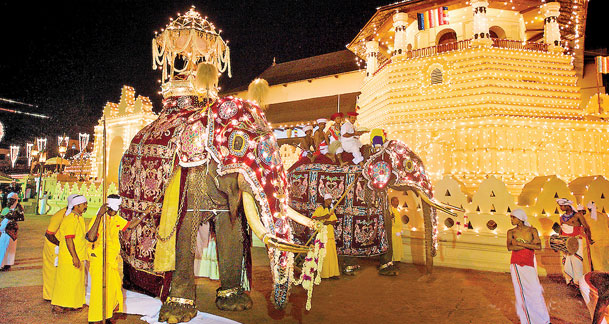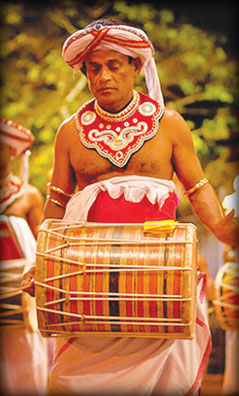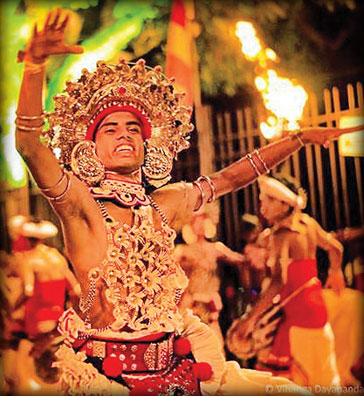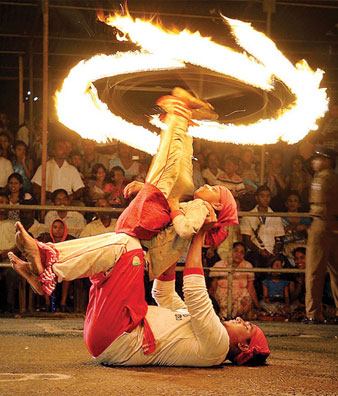|
Kandy Perahera:
Pageant spanning centuries
By Kalakeerthi Dr. Edwin Ariyadasa
 The Kandy Perahera is the world's oldest recorded spiritual pageant.
It originated way back in 371AD, during the reign of King Sri Meghavanna.
The devoted king received the sacred Tooth-relic from Prince Danta and
Princess Hemamala, with unreserved reverence and overwhelming devotion. The Kandy Perahera is the world's oldest recorded spiritual pageant.
It originated way back in 371AD, during the reign of King Sri Meghavanna.
The devoted king received the sacred Tooth-relic from Prince Danta and
Princess Hemamala, with unreserved reverence and overwhelming devotion.
The intriguing odyssey of the passage of the Sacred Tooth Relic, from
India to Sri Lanka ranks high among the spiritual sagas of mankind. To
safeguard this object of utmost holiness, Princess Hemamala had the
sacred Tooth Relic, concealed in her coiffure, while travelling from
Kalinga to this Island, with her consort Prince Danta accompanying her.
In what worldly adventure, not to say anything about a rare spiritual
adventure of this kind, can we find an individual resorting to such a
strategem?
The King, in his boundless fervour, invested 90,000 Kahapanas (gold
coins) to launch the first-ever Tooth Relic festival of mankind. The
pious and dedicated monarch established the precedents for the
subsequent Tooth Relic Festivals, enabling his successors to adapt his
template.
Interesting
During the 1645 years that have elapsed, since the arrival of the
Tooth Relic in Sri Lanka, the festivities relating to the Sacred Tooth
Relic, have evolved along an astonishingly chequered path. The cult
attracted pilgrims and devotees from the far corners of the then known
world. Some of the records linked to these visitors, are memorably
interesting.
  A Chinese Buddhist Pilgrim, from a background of exceptional
affluence, paid his homage to the sacred Tooth Relic. But, to this
devotee that was not at all good enough. He had an audience with the
country's ruler, and presented him some exotic gifts. He had a request
to make to the King. A Chinese Buddhist Pilgrim, from a background of exceptional
affluence, paid his homage to the sacred Tooth Relic. But, to this
devotee that was not at all good enough. He had an audience with the
country's ruler, and presented him some exotic gifts. He had a request
to make to the King.
He addressed the King: "You majesty, please sell me the Sacred Tooth
Relic. I will pay your majesty any price you indicate."
Immensely amused by his strange request the King smiled and assured
the fervent pilgrim that he will not sell the Holy Tooth Relic for
anything, anyone could offer.
With all the fluctuations that have taken place over the past ages,
some of the perennial rites and rituals have remained largely unchanged.
When you take even a casual look at the unbelievably multi-faceted
ritual requirements essential for the performance of the annual pageant,
you will invariably concede that, this must undoubtedly be one of the
world's most complex spiritual ceremonies.
What the pilgrim, the spectator or the tourist observes when the
pageant passes in front of one, is merely the proverbial tip of the
ice-berg. The intricate preparatory processes that have been going on
for long months before the annual pageant appears to the spectators, are
largely unseen by a vast mass.
Take for instance the preliminary ritual of the planting of the
perennial tree (kup-situveema). There is a special performer chosen to
cut the tree. A retinue of supporters attend on him.
In the early days of the pageant the king himself supervised the
preparation, and gave verbal orders to commence the procession.
An extensive array of officials is assigned various tasks, some have
to calculate the auspicious hours for various rites and rituals. A
secretary armed with writing material and the styles, has to walk along
the procession. A vast variety of flags, some in brass, most others in
cloth, have to be ready, to represent various administrative regions of
the Island. An assembly of leading monks and outstanding officials
decodes the crucial issues relating to the performances.
 In all these, the clergy leadership is traditionally assigned to the
Chief Prelates of the Asgiri, Malwatu Chapters of the Siamese sect.
These two Chapters preside over the rituals in rotation. In one year the
Asgiri Chapter will be in charge of the Perahera ritual, and in another,
the Malwatu Chapter will take over. In all these, the clergy leadership is traditionally assigned to the
Chief Prelates of the Asgiri, Malwatu Chapters of the Siamese sect.
These two Chapters preside over the rituals in rotation. In one year the
Asgiri Chapter will be in charge of the Perahera ritual, and in another,
the Malwatu Chapter will take over.
But, Prelates and other hierarchical authorities will always
supervise the total range of ritual.
The lay leader who exerts his influence over the perahera matters is
the Diyawadana Nilame. The incumbent is Dela Bandara Diyawadana Nilame.
The perahera follows a traditionally established Order.
The pageant-ritual is initiated with the Kumbal Perahera. Tradition
holds that, this Kumbal Perahera is exclusively for children. The
purpose of this perahera is to dispel evil influences that are likely to
affect young ones. This Kumbal Perahera is something of a
curtain-raiser. Even such performers as drummers who participate in the
Kumbal Perahera have no elaborate adornments. The elephants too, are not
caparisoned attractively.
Stature
A major component of the formal Perahera is the Randoli Perahera. In
the days of royal rule, the Chief Queen took part in the parade,
travelling in a palanquin. In later years, the palanquin was a symbolic
item, since the Chief Queen did not travel in it .
The stature of the Queens, was graded with names of metals. There
were gold, silver and iron palanquins, at one stage in these
processions.
The most panoplied procession was the ultimate parade held on the
fifth and the last day of the series of the procession. The perahera
elephants are caparisoned in the festive best.
It is at this climactic Maharandoli Perahara, that the Diyawadane
Nilame appears in his full official attire, adding a touch of glory to
the total pageant.
In an in-depth study of the background details of the great pageant,
one cannot help but be totally overwhelmed by the endless preparations
that are called for. There is a family, traditionally responsible for
the elephant caparisons. Some performers represent a tradition that
began in the distant past.
I am not too sure, whether any authoritative effort has been made to
place on record those extensive efficiencies, that contribute towards
the glory of the Nuwara Perahera. The relevant authorities could
initiate the process, to chronicle all aspects of this globally reputed
pageant.
 Objectively viewed, the Kandy Pageant could very well be the world’s
most attractive and intriguing spiritual festival of mankind. At one
time it was reported, that the Relic casket-bearing the majestic
elephant, the late Raja, was the world’s most photographed animal. Objectively viewed, the Kandy Pageant could very well be the world’s
most attractive and intriguing spiritual festival of mankind. At one
time it was reported, that the Relic casket-bearing the majestic
elephant, the late Raja, was the world’s most photographed animal.
Spectacular
It is essential to devote a concerned research effort to record the
human side of those thousands of families, who, jointly contribute
towards the spectacular vision provided by the perahera. We could extend
the boundaries of such a research to include the life-details of animal
participants, specifically the Perahara Elephants.
It is generally known that some of the noble beasts get emotionally
involved in the pageant.
An experienced individual once told me, there was a perahara-Elephant,
that would place its brow on the steps of the Temple of the sacred Tooth
Relic, with its eyes welling with emotional tears.
But, about the current Esala Perahara, I heard a piece of very
welcome news.
The Temple authorities, according to what I heard have appointed a
team of electronic media experts to make a detailed visual chronicle of
the Perahera and its associated events and locations. Accordingly, a
young expert in electronic media, Taranga Wickramadasa, has been
assigned to lead a team for this electronic chronicle.
The world, as much as Sri Lanka, urgently needs a comprehensive print
media chronicle of all aspects of the Temple of the Sacred Tooth Relic.
If this is not given urgency, some remarkable details relating to this
globally venerated shrine will be irretrievably lost.
Time to act is now. |

